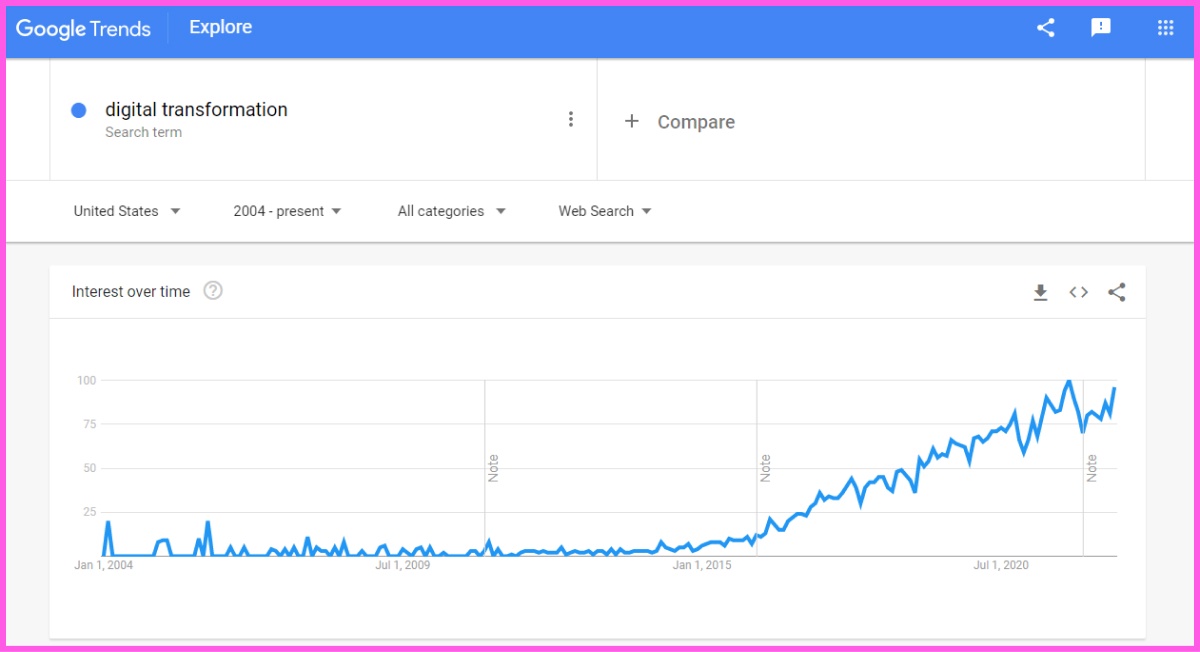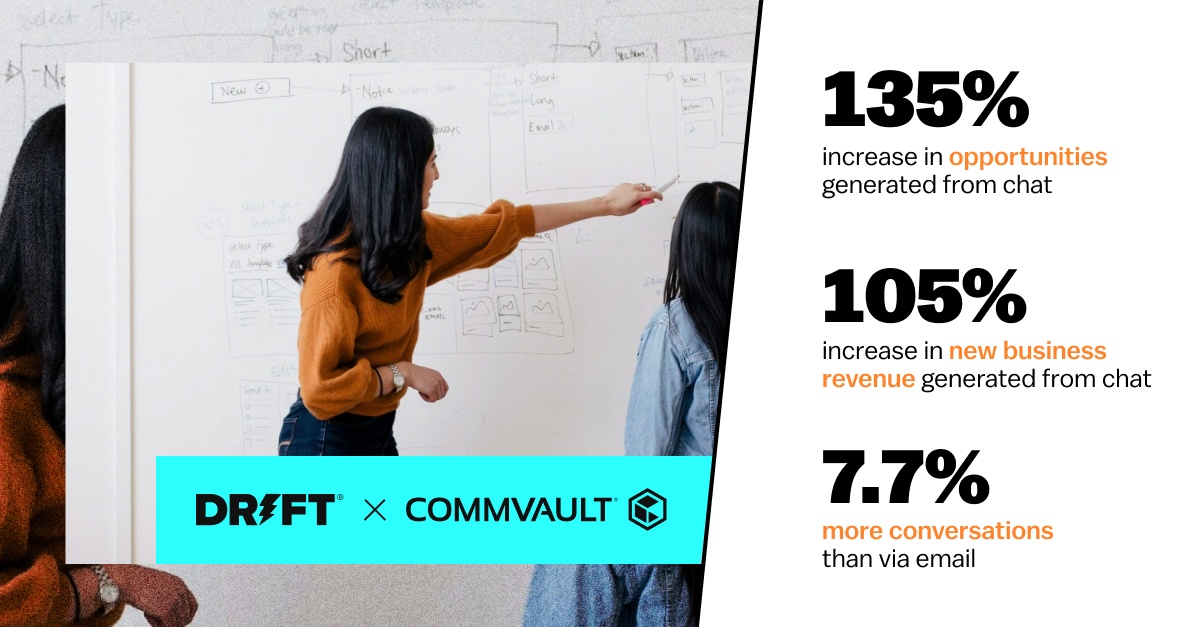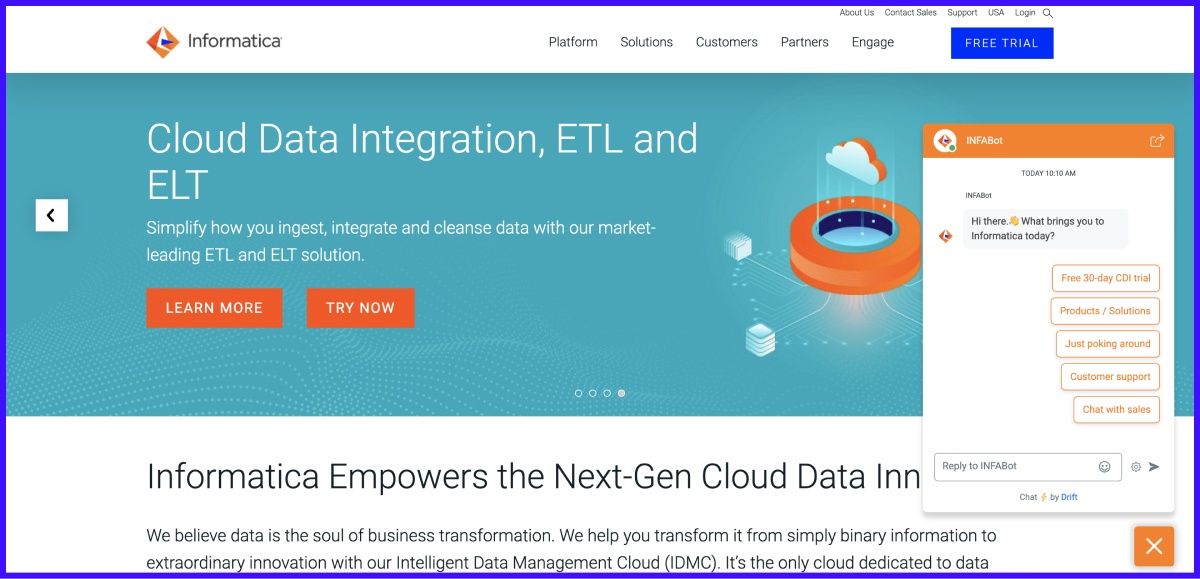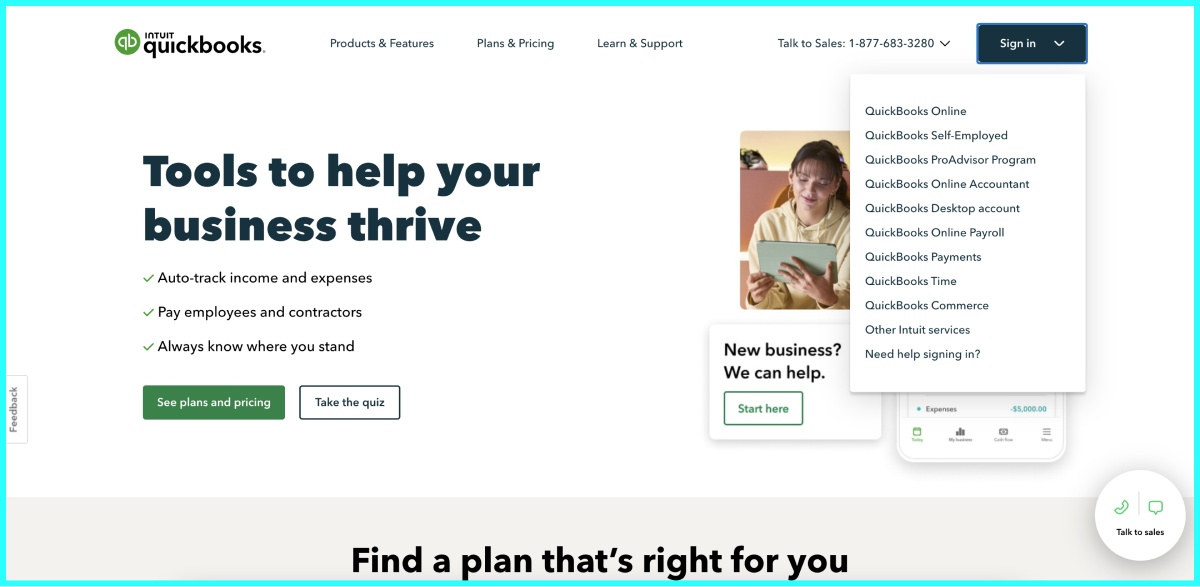Digital transformation may have been a buzzword several years ago, but now it’s a mainstay. If you want to secure success for your company for the long haul, digital transformation is the way to go.
But you might be confused about what digital transformation actually does.
Digital transformation is more than just digitization, i.e. moving things online.
It’s about innovating the entire customer experience and continuously revamping business processes to drive greater value. It’s about answering questions like:
- How can we save money?
- How can we protect ourselves against disruptors?
- And how can we adopt the right technologies to create the right experiences?
Here, we dive into what digital transformation is, some real-life examples, current trends, and how you can actually achieve it.
What Is Digital Transformation?
Digital transformation is the process of adopting new digital technologies to evolve services and internal processes so companies can adapt to modern business and customer expectations — or supersede them. Usually, the goal is to retain and attract customers, as well as create more operational efficiency.
And we’re not just talking about your website. Digital transformation spans every department and function of a business, from automated customer experiences to more effective employee onboarding.
In addition, digital transformation is a continuous process. According to Google Trends, searches for digital transformation in the United States peaked in October of 2021, when businesses were still scrambling to adapt to pandemic-caused digital acceleration. But even now, the topic of digital transformation is almost twice as popular as it was just three years ago.

All this is to say that digital transformation is far more than a single software purchase. In the coming years, as the popularity of digital transformation grows even more, businesses will need to maximize their usage of technologies that might not even exist yet to improve both customer experiences and business processes.
Why Is Digital Transformation Important?
Digital transformation allows businesses to keep up with changing customer expectations and pave the way for future growth. That’s important because, in today’s competitive markets, your customer experience is what will make or break you.
According to PwC, 73% of people worldwide stated that a positive customer experience is an important factor in their purchasing decisions, with 65% of US customers saying that it has a bigger impact than great advertising. This means the obsession with customer needs and expectations isn’t overrated — it truly will make your business successful.
And digital transformation is the best way to innovate those customer experiences. For example, in 2020, the demand for immediate responses grew by 64% year-over-year. By adopting chatbots, businesses can meet these expectations and speed up the sales process.
There are also endless internal processes that can be made more efficient with technology, such as AI. In fact, 74% of marketers believe that they will be using AI to automate a quarter of their tasks over the next five years. And when it comes to sales, AI can automatically qualify buyers so that 76% of sellers don’t have to spend their time meeting with unqualified buyers.
In sum, digital transformation empowers businesses to drive greater efficiency and maintain competitiveness — which can save an enterprise from complete ruin. Consider the cautionary tale of Blockbuster: Their refusal to adapt to an online streaming model and purchase Netflix in its infancy led to the disappearance of over 9,000 stores across the US.
Like with Blockbuster, without digital transformation, companies risk:
- Losing ground to disruptors and existing competitors
- High turnover and inability to compete for the best talent
- Continuously high overhead costs due to the lack of technology adoption
- Inability to create multichannel relationships with customers (and collect revenue from different channels)
- Low profits, short runways, and the possibility of going bankrupt
“Innovate or die” is a factual statement. Just think about why Ford is moving away from muscle cars to electric vehicles; they need to appeal to mass American consumers who want to save on gas. This is the same for every business. If your goal is to come out on top, you need to meet your customers where they are — and that means investing in digital transformation so you can get with the times.
Digital Transformation Examples
Even with a definition, digital transformation can still feel like a nebulous concept. And considering that it looks different for every organization, this confusion is warranted. To give you a more concrete idea, here are some real-life examples of digital transformation.
Commvault
Just named a leader in Gartner’s Magic Quadrant for Enterprise Backup and Recovery Software Solutions for the 11th time, Commvault has more than secured its spot at the head of the data management, security, and compliance industry. The company has led the way with cloud and hybrid offerings while also going above and beyond with data transformation solutions that help companies seamlessly integrate and repurpose their data.
But they aren’t just innovators when it comes to their products and services. They also innovate their internal processes.
Commvault’s former Director of Web Marketing, Mike Impelluso, noticed that customers had a much easier time conversing with Commvault than buyers did. And seeing the negative impact that had on their pipeline, he set out to fix that.

Mike decided to implement Drift’s live chat solution because it could automate conversations with prospects, provide consistent messaging, encourage prospects to sign up for virtual events, and fast-track conversations with qualified leads.
Drift made it easier for the Commvault brand to transition into becoming more conversational, allowing them to create a better (and more fun) buying experience while increasing the sales team’s productivity. As a result, they achieved a 135% increase in opportunities generated from chat and a 105% increase in new business revenue compared to their old chat solution.
Microsoft Office
Google Drive, Docs, Sheets, and Slides might be the tools of choice for many students and startups, but Microsoft Office hasn’t let the Google Suite bring them down. Still the world’s top productivity suite, Microsoft Office is used by 1.2 billion users around the world.
The company brought files into the cloud in 2012, keeping pace with cloud computing trends and customer demands. Today, Microsoft Office users can easily sync their files across all devices, switching from working on their office desktop to their home laptop in seconds.

Partly the result of their online suite of productivity tools, the company’s revenue has been growing 12–17% year-over-year since 2019. That is a seriously impressive feat for a company that was founded in 1975.
Informatica
Informatica has assisted 85 out of the Fortune 100 (and all of the top 10) in achieving digital transformation when it comes to creating, storing, processing, and scaling data.
But on their own website, Informatica was struggling with their legacy chat solution, which — combined with unoptimized processes — resulted in an average response time of 24 to 72 hours.
To deliver a buying experience that reflected their innovative spirit, Informatica’s web team installed Drift with the goal of speeding up response times and aligning their sales and marketing teams. They did this by rolling out chatbots on high-intent pages to fast-track buyers to sales, as well as designing personalized playbooks to take buyers further down the funnel.

With a streamlined digital experience, Informatica was able to reduce their response times to 30 seconds, while enabling them to naturally build rapport with their buyers instead of pushing the sale. Compared to their old chat solution, this led to a 2x increase in the number of opportunities and a 30% increase in meetings booked.
It’s no surprise that a lot of digital transformation is centered around optimizing digital processes — it builds pipeline, enhances the customer experience, and reduces frustration all around. And, as in Informatica’s case, it instantly aligns different teams around a common goal, paving the way for a better, faster experience.
Disney+
Launched in November of 2019, Disney+ brought the nearly 100-year-old company to the streaming age. Founded in 1923, Disney has since managed to innovate around entertainment, gaming, retail, and travel.
Prior to launching their streaming service, the company had placed its movie classics in a vault, only rereleasing them every few years for purchase. While this strategy worked during the age of at-home VHSs and DVDs, it became irrelevant amidst the always-on access that new streaming services provided.

Without the power of Disney and its existing catalog of movies, launching a streaming service in 2019 might have been too late. But the platform recently surpassed 151 million subscribers, making it the third most popular video streaming service in the US behind Netflix and Amazon Prime Video.
QuickBooks
Launched in 1983, QuickBooks easily could have been one of those on-premise solutions that got clobbered by a hot new SaaS product. But instead, seeing the trend towards cloud computing, the company released its first cloud-based product in 2001.
As early as 2002, QuickBooks also made the wise move to split their enterprise products from their small business ones. By doing so, they ensured that they would continue to gain traction with large enterprises while winning over small business owners and small accounting firms.
Today, they offer several different products, so no customer has to deal with accounting software that is either too complex or too simple. For example, they have QuickBooks Online for small LLCs and corporations while QuickBooks Desktop is commonly used by enterprises.

With their early advances into cloud-based solutions and their smart customer-centric strategy, QuickBooks has become one of the biggest names in the accounting industry. And it’s now a go-to for small and medium-sized businesses — with QuickBooks Online serving seven million customers globally.
Digital Transformation Trends
There are so many new technologies coming onto the market every day — and digital transformation is certainly not immune to the power of these trends. After all, the more companies that adopt and use a new technology, the more customers begin to expect it from all the companies they interact with… and so on.
Today, many digital transformation trends center around maximizing productivity and ironing out remote and hybrid work processes to meet modern buying expectations. These trends include:
- Using AI to improve the buying experience and deliver faster customer service
- Improving remote and hybrid work through productivity software and cloud-based apps
- Modernizing applications and rebuilding them with developer-favorite frameworks
- Safeguarding customer data and maintaining clean data lifecycles
- Reducing cybersecurity risks and software vulnerabilities
- Using machine learning including for predictive analytics, predictive text, and predictive product pairings
- Continuing to improve multichannel experiences and integrating new channels and data sources
How to Measure the ROI of Digital Transformation
There’s a lot you can achieve through digital transformation — but it would all be meaningless if you didn’t know how to talk about your results. So how do you measure something like digital transformation?
First, establish the goal of your digital transformation initiative. Once you know what you’re working towards, make sure your team agrees on what metrics you will track. These might not directly translate into revenue but you can use them to gauge the impact on your larger business goals.
For example, if you’re using AI to speed up your customer service, you might measure time to first response, time to resolution, number of customers assisted per hour, and CSAT. With these numbers, you can figure out the impact on your customer experience, retention rate, and word-of-mouth referrals.
You should also decide on a timeframe for measuring your results, as well as how frequently you will report on those metrics. By putting these plans in place, you will be able to track your results and iterate on your strategy, while also continuously keeping high-level goals in mind.
Now, all that’s left is to measure your overall results. If you’re using a solution that directly impacts revenue, this will be easier. For example, if you adopt a Conversational AI solution to replace contact forms, you can measure the cost of the platform against its impact on pipeline, closed deals, and overall revenue.
ROI = Revenue driven by digital transformation / cost of digital transformation X 100
Regardless of whether you’re a small business or an enterprise company, you should always measure the success of your digital transformation efforts. Not only does this give you a clear picture of the impact that digital transformation has on your business, but it also makes it easier to secure buy-in for the next big project.
How to Get Started in Digital Transformation
Digital transformation can be daunting. No matter the initiative, it almost always represents a massive change. But it’s easy — as long as you take it one step at a time.
The first is to come up with a strategy for digital transformation. This might include identifying weak points, analyzing your competitors’ experiences, and interviewing customers.
From there, it’s all about deciding what to tackle first and how to do it. Here, you can lean on your employees to provide insights from previous companies. Or, you could hire a digital transformation consultancy to help you pinpoint improvements that will bring in the most ROI.
Again, digital transformation looks different for every company — so it’s important that, throughout all this, you’re keeping your business goals in mind. Ultimately, you want to focus on solutions that will help your business thrive and deliver a customer experience that will keep people coming back for more.
Still not sure where to start? Well, what about a conversational platform that drives buyer-centric experiences and has proven up to a 670% ROI?
Drift Conversation Cloud empowers buyers and customers to engage with you on their terms in every interaction. It breaks down the silos between your revenue teams and ensures quality pipeline and revenue, all while delivering a memorable and hyper-personalized customer experience. Find out just how much revenue you’re missing out on without Drift — or get a demo today to learn exactly how we can help kickstart (or elevate) your digital transformation.